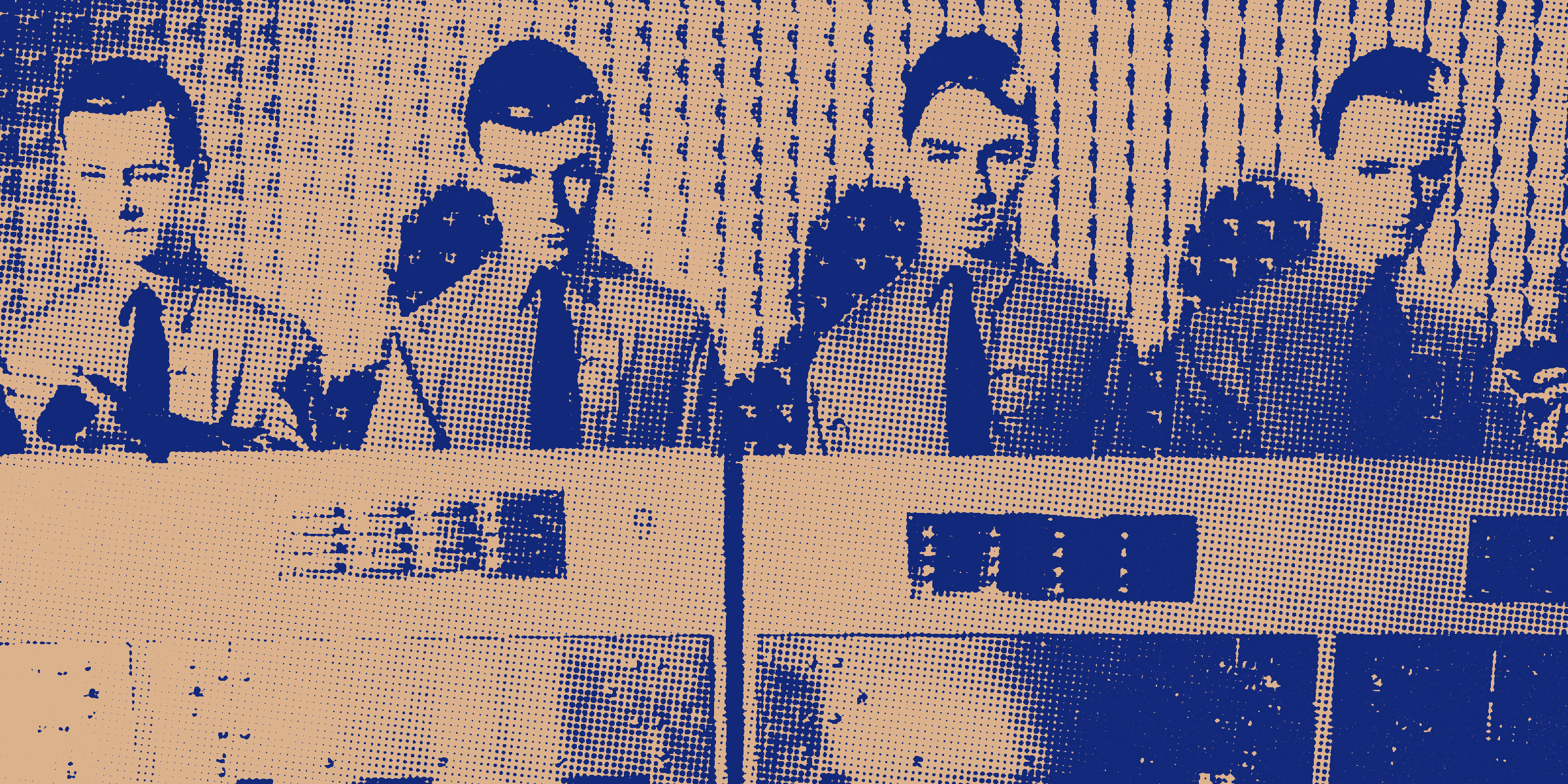The history of Kraftwerk (and the world as we now know it)
Uncover the groundbreaking career of Kraftwerk, the electronic music pioneers who reshaped the musical landscape. Explore their iconic journey of innovation and influence.

Kraftwerk was the very first artist I can remember listening to as a child. The "mosquito music" in my toddler vocabulary would come to define so much of the sonic landscape I would later explore and write myself. If not turning into a robot myself, than like many others, being influenced by this curious and objective strange and complelling act that looked (and sounded) nothing like where I was born in the Australian outback. Which might give a clue to depth and distance of this unlikely group becoming, without little doubt, one of the most influential and innovative bands in the history of modern music.
These stories are no doubt ubiquitous, where few bands have been as transformative and influential as Kraftwerk. Formed in the German city of Düsseldorf in 1970, this quartet didn't just play music—they sculpted soundscapes, painting vivid pictures of a future where machines and humans coexist. Not in the obscure and obtuse ways of Music Concrete that emerged from neighbouring France, but in a serious-faced but playful pop-synth form. Their pioneering role in electronic music has left its mark on a multitude of genres and artists, making them one of the most significant bands in music history.
The early history of Kraftwerk
The story of Kraftwerk begins in the late 1960s in Düsseldorf, Germany, a time when the country was undergoing significant cultural and social change. Amidst this backdrop, two students from the Robert Schumann Hochschule, Ralf Hütter and Florian Schneider, came together to form a band that would later revolutionize the music industry.
Kraftwerk, meaning "power station" in German, was born out of Hütter and Schneider's shared vision of creating a new kind of music, one that broke away from traditional rock and pop structures. Their early experiments with electronic instruments laid the foundation for the unique sound that would become Kraftwerk's trademark.
In the early years, the band's lineup saw several changes. Hütter and Schneider were joined by various musicians, including drummer Klaus Dinger and guitarist Michael Rother. However, it was the addition of electronic percussionists Wolfgang Flür and Karl Bartos in the mid-1970s that solidified the classic Kraftwerk lineup. Despite these changes, Hütter and Schneider remained the core members, driving the band's unique sound and vision.
Kraftwerk's early music was experimental, characterized by improvisation and a heavy use of electronic instruments. However, with the release of their fourth album, "Autobahn," in 1974, the band found their voice. The title track, a 22-minute musical journey that mimicked the experience of driving on the German autobahn, was a breakthrough for the band, bringing them international recognition.
Over the years, Kraftwerk continued to evolve, both musically and technologically. They embraced the latest advancements in electronic instruments and recording technology, using them to create a sound that was uniquely their own. Despite the changes in the music industry and the rise of new genres and trends, Kraftwerk remained true to their vision, continuing to produce music that was innovative, influential, and unmistakably their own.
Musical Style and Innovation
Kraftwerk's music is characterized by its innovative use of electronic instruments to create minimalist, repetitive melodies and rhythms. They were among the first to fully embrace the potential of technology in music, using synthesizers, drum machines, and vocoders to create a futuristic sound that was entirely new.
Their early work was experimental, often characterized by long, improvisational pieces. However, with the release of "Autobahn," Kraftwerk began to develop a more structured approach to their music. The title track, a 22-minute piece that mimicked the experience of driving on the German autobahn, was a perfect example of this. It was a composition that was both complex and accessible, a testament to Kraftwerk's musical genius.
Kraftwerk's innovative use of technology was not limited to their music. They were also pioneers in the use of visuals in their live performances. From the beginning, they recognized the potential of combining music with visual elements to create a complete sensory experience. They incorporated animations, robotics, and even mannequins into their performances, creating a spectacle that was as much about the visuals as it was about the music.
This innovative approach to performance was far ahead of its time. Today, it is common for artists to incorporate visuals into their performances, but in the 1970s, this was a revolutionary concept. Kraftwerk's concerts were not just concerts—they were multimedia events, a testament to their innovative spirit and their commitment to pushing the boundaries of what was possible in music.
Kraftwerk's musical style and innovation have had a profound impact on the music industry. They have influenced countless artists and have paved the way for the rise of electronic music. Their innovative use of technology, both in their music and in their performances, has redefined what is possible in music, making them true pioneers in the field.
Key Albums and Biggest Hits
Kraftwerk's discography is a testament to their musical evolution and innovation. Their 1974 album "Autobahn" marked a turning point for the band. The title track, a 22-minute musical journey that mimicked the experience of driving on the German autobahn, was a breakthrough. The song, with its repetitive electronic melody and use of ambient sounds, was unlike anything that had been heard before. It was a commercial success, reaching the top 30 in the US and UK charts and introducing Kraftwerk to a global audience.
Following the success of "Autobahn", Kraftwerk released a series of concept albums from their mysteriously (or amusingly?) named "Kling Klang" studios that further solidified their status as pioneers of electronic music. "Radio-Activity" (1975), a meditation on the theme of radio communication, showcased the band's ability to create music that was not only sonically innovative but also thematically complex. "Trans-Europe Express" (1977) and "The Man-Machine" (1978) continued this trend (with my childhood favourite "The Robots"), with each album exploring themes related to technology and humanity's relationship with it.
Kraftwerk's biggest hits, such as "Autobahn", "The Model", and "Tour de France", showcase their ability to create catchy, accessible music within their experimental framework. "The Model", from the album "The Man-Machine", became a surprise hit in the UK, reaching number one on the singles chart in 1982. "Tour de France", released in 1983, was another commercial success, with its cycling-inspired rhythms and melodies capturing the spirit of the famous bicycle race.
These songs, with their distinctive melodies and rhythms, have become iconic pieces of electronic music. They demonstrate Kraftwerk's ability to create music that is both innovative and accessible, music that pushes the boundaries of what is possible while still appealing to a wide audience. This balance between innovation and accessibility is one of the reasons why Kraftwerk's music has had such a lasting impact.
Equipment and Technology
Kraftwerk's sound was shaped by their innovative use of electronic instruments. They were among the first bands to fully embrace the potential of technology in music, using a variety of synthesizers, drum machines, and other electronic devices to create their unique sound.
In their early years, Kraftwerk used a variety of instruments, including traditional ones like the flute and the violin. However, they soon began to experiment with electronic instruments. They used a variety of synthesizers, including the Moog Minimoog and the ARP Odyssey, to create their distinctive electronic soundscapes. They also made use of drum machines, which allowed them to create complex, repetitive rhythms.
One of Kraftwerk's signature sounds was the use of the vocoder, a device that can manipulate and transform vocal sounds. The vocoder became a key part of Kraftwerk's sound, used to create the robotic, otherworldly vocals that are a hallmark of their music. Kraftwerk also built their own electronic percussion pads, which were played by Wolfgang Flür and Karl Bartos. These custom-made devices allowed the band to create a wide range of percussive sounds, adding another layer to their complex musical compositions.
This hands-on approach to technology was a key part of Kraftwerk's creative process. They were not just musicians—they were also inventors and innovators, constantly pushing the boundaries of what was possible with technology. This innovative spirit is one of the reasons why Kraftwerk's music remains so distinctive and influential today.
Cultural Impact
Kraftwerk's influence extends far beyond the realm of music. Their futuristic aesthetic, with their robotic movements and man-machine imagery, has left a lasting impact on various aspects of popular culture, including fashion, film, and art.
Their music, with its themes of technology and futurism, resonated with a society that was rapidly becoming more technologically advanced. Their image, with their matching outfits and robotic personas, became iconic, influencing fashion trends and inspiring countless artists and designers.
In film, Kraftwerk's music has been used to underscore scenes of urban landscapes and technological advancements, their futuristic sound perfectly complementing the visuals. Their influence can also be seen in the realm of visual arts, with numerous artists citing Kraftwerk as an inspiration for their work.
In addition to their influence on popular culture, Kraftwerk's music has also had a significant impact on various musical genres. Their innovative use of electronic instruments and their unique sound have influenced a wide range of artists, from synth-pop bands like Depeche Mode and New Order to techno artists like Richie Hawtin and Jeff Mills. Even in hip hop, a genre seemingly far removed from Kraftwerk's electronic soundscapes, their influence can be felt. Artists like Afrika Bambaataa and the Beastie Boys have sampled Kraftwerk's music, demonstrating the wide-reaching impact of their sound.
Kraftwerk's contributions to music and culture have been recognized with numerous awards and accolades. In 2014, they were awarded a Grammy Lifetime Achievement Award, a testament to their enduring influence and their significant contributions to the music industry.
Legacy and Influence
Kraftwerk's legacy is evident in the countless artists who cite them as an influence. Bands like Depeche Mode and New Order borrowed from their electronic palette to create their own synth-pop hits. Daft Punk, the French duo known for their electronic music, have often acknowledged Kraftwerk's impact on their work. Even in hip hop, pioneers like Afrika Bambaataa have sampled Kraftwerk's music, demonstrating their cross-genre influence.
The influence of Kraftwerk extends to the world of DJing and electronic dance music as well. Artists like Richie Hawtin, Carl Craig, and Juan Atkins, often referred to as the "godfathers of techno," have all cited Kraftwerk as a major influence. Their minimalist, repetitive beats and melodies laid the groundwork for the techno music that emerged from Detroit in the 1980s.
Kraftwerk's influence can also be seen in the realm of pop music. Artists like Madonna and Coldplay have acknowledged the influence of Kraftwerk on their music. Even the pop superstar Lady Gaga has cited Kraftwerk as an influence, demonstrating the wide reach of their music.
Today, their influence continues to resonate in the music of contemporary artists across various genres, from electronic to pop to hip hop. Their innovative use of technology, their distinctive sound, and their visionary approach to music-making have left a lasting legacy, making them one of the most influential bands in the history of music.
In addition to their influence on music, Kraftwerk's vision of a technologically advanced future has also become a reality. Their music, once considered futuristic, now sounds remarkably prescient. In a world where technology is an integral part of daily life, Kraftwerk's music serves as a reminder of the possibilities and challenges that this new reality presents.
Conclusion
Kraftwerk's significance in music history cannot be overstated. They transformed the musical landscape with their innovative use of technology and their visionary approach to music-making. Their music painted a picture of the future, a world where humans and machines coexist in harmony. This vision, once considered avant-garde, is now a reality, making Kraftwerk not just pioneers, but prophets of the digital age.
Their influence extends far beyond the realm of electronic music. From pop to hip hop to techno, their innovative sound has left its mark on a wide range of genres. Their music has been sampled by countless artists, and their aesthetic has influenced fashion, film, and art. Today, more than five decades after their formation, Kraftwerk's influence continues to be felt in the music industry and beyond.
But perhaps the most significant aspect of Kraftwerk's legacy is the way they have shaped our understanding of what music can be. They showed us that music is not just about melodies and rhythms, but also about ideas and visions. They showed us that music can be a tool for exploring the future, for questioning our relationship with technology, and for imagining new possibilities.
In the end, Kraftwerk's story is not just about music. It's about innovation, vision, and the power of ideas. It's about the courage to break with tradition and to chart your own path. And above all, it's about the enduring power of creativity. As we look to the future, Kraftwerk's music serves as a reminder of the limitless possibilities that lie ahead. Their influence continues to resonate, making them a truly timeless band.


